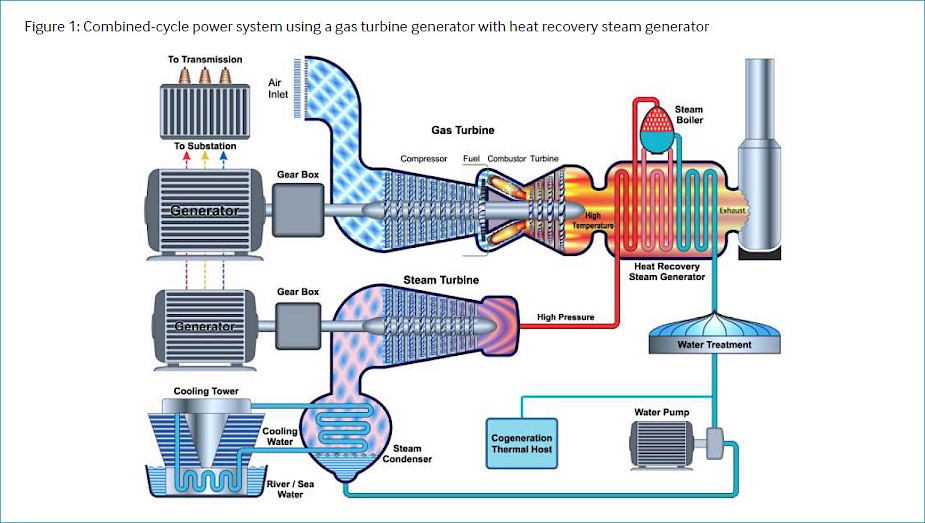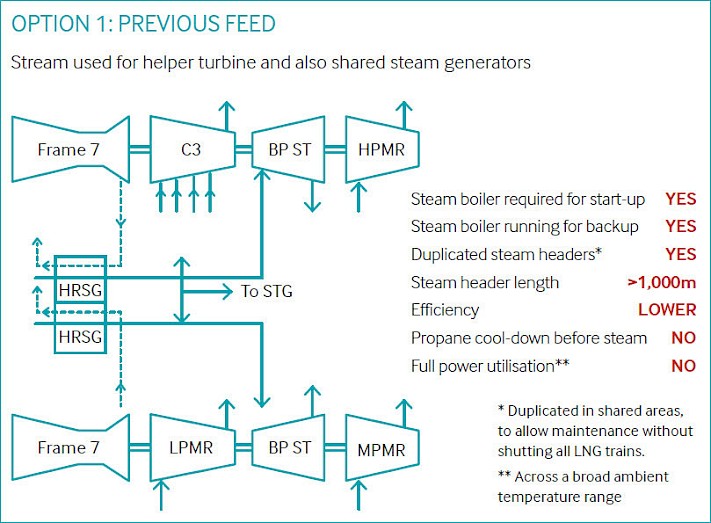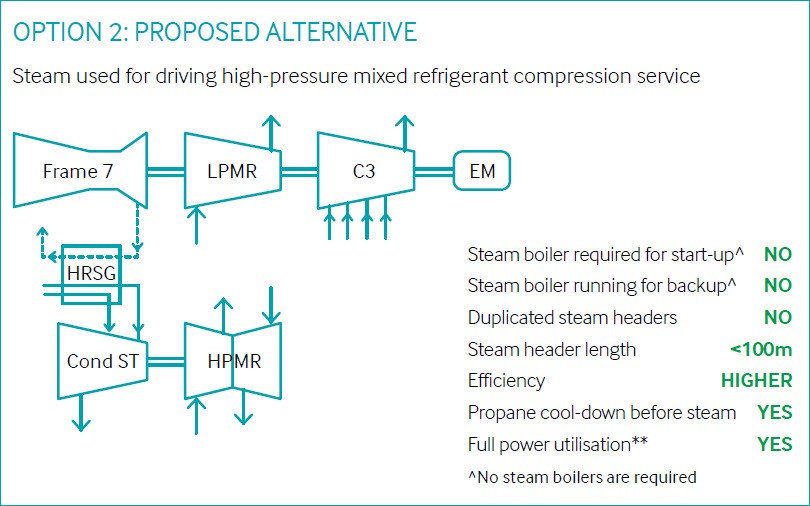Topic last reviewed: November 2022
Sectors: Upstream, Downstream
Category: Power and heat generation
A combined-cycle gas turbine (CCGT) power plant uses the exhaust heat from gas turbines to generate steam with a heat recovery steam generator (HRSG). The produced steam is then fed to a steam turbine to provide additional power, either running a generator or as a mechanical drive. The overall efficiency of an offshore CCGT is approximately 50%. An onshore CCGT has increased efficiency due to additional pressure levels and reheat circuits, and it has an overall efficiency of approximately 60%.
The efficiency drops significantly at partial load. The typical simple-cycle efficiency is 33–43% at maximum load and drops significantly at partial load. The efficiency for a CCGT will vary with size and type of turbine selected. But tends to increase with the size of the turbine.
A combined-cycle power system is an established technology for larger, onshore power generation plants. The technology has also been used on three offshore installations for over 20 years in Norway. Offshore operators have experienced various corrosion issues and fatigue of tubes in the HRSG, mainly caused by maloperation. The key challenge has been to follow the operational procedures and have good water quality management. After 20 years, these CCGTs are still in operation.
Technology description
Figure 1 illustrates a typical CCGT application in an oil and gas environment.

For a more detailed description of this technology in typical onshore applications, please refer to Reference 1, Reference 2 (general information in the section on cogeneration), and Reference 3.
Cogeneration is the recovery of waste heat instead of using fired heaters and electrical boilers to generate heat, thereby increasing the useful work from the fuel and reducing the system`s carbon footprint meanwhile improving the overall system efficiency. The heating medium is usually steam, hot water, or a heating oil. On an installation where the heat demand is large, the waste heat from the HRSG may be prioritized for heating applications over electrical generation – see the topic Combined Heat and Power. Due to changing heat and power demand through the project, using all available heat over the project life cycle can be difficult.
The selection of a combined-cycle configuration depends on the power and heat demand and their stability. Combined-cycle technology is likely to offer the best life-cycle cost for larger plants, with low process heat demand.
Offshore
Most offshore installations have selected open-cycle gas turbines (OCGTs), as they offer reduced size and weight (per megawatt installed) but with lower energy efficiency and higher fuel consumption per unit output. Combined-cycle system operation is most suitable for relatively stable load applications and may be less suitable for variable or declining load profiles. In a new ‘greenfield’ development incorporating a combined-cycle system design, the size of the gas turbine can be reduced compared with an open-cycle configuration. Additionally, the HRSG can replace the gas turbine silencer, thereby mitigating some of the space and weight constraints. For an offshore combined cycle power plant, a vertical (forced circulation) HRSG is preferred due to weight and footprint considerations.
Onshore
With less space and weight constraints, and for generally more stable power and heat demand, onshore plants more oen utilize CCGTs or combined heat and power to achieve lower life-cycle costs. Additional CCGT costs, including additional design complexity, and capital expenditure (capex), and maintenance, are usually exceeded by the improved energy efficiency and reduced fuel operating expenditure OPEX of CCGTs. Some onshore CCGTs (more typically in North America than Europe) have a horizontal (natural circulation) HRSG, but the horizontal layout uses a lot of plot space. Many European onshore plants tend towards forced circulation vertical boilers – a pump duty is introduced but plot space is saved.
Retrofitting gas turbine generator technology to convert from OCGTs to CCGTs poses typical brownfield challenges of complexity, cost, and deferred production in an operating plant; hence, upgrades are uncommon. This is particularly true for offshore installations, where topside weight and space constraints may not allow additional steam infrastructure and personnel to operate it.
Technology maturity
| Offshore | Onshore | |
|---|---|---|
| Commercially available | Yes | Yes |
| Offshore viability | Yes | Yes |
| Brownfield retrofit | Yes, in some scenarios | Yes, in some scenarios |
| Years of experience in industry | >50 (power industry) | |
| Years of experience in oil and gas industry | >20 offshore | >50 |
Key metrics
| Offshore | Onshore | |
|---|---|---|
| Range of application | 10 ~ 30 MW | Typically, over 30 MW |
| Efficiency | Generally, less than onshore, i.e., <50%, due to variable power and heat demand | 50–63% (overall power generation efficiency), a significant improvement over open-cycle efficiencies of around 33–43%. |
| Energy key performance indicators | Effective electrical efficiency Total system efficiency | Effective electrical efficiency Total system efficiency |
| Guideline capital costs | Offshore greenfield: more expensive than open-cycle Offshore brownfield: studied, but no known cases implemented | See Reference 4, turbine chapter |
| Guideline operational costs | Less fuel is used, saving operational costs and reducing greenhouse gas (GHG) emissions costs. | Note: purchased fuel, no carbon cost |
| Guideline life-cycle costs | If fuel is purchased, may have attractive life-cycle costs. If fuel is reduced and saleable hydrocarbons increased, may have attractive life-cycle costs, depending on gas price. If high GHG emission cost, life-cycle cost will be even more attractive. | Lower than open-cycle. Dependent on usual factors, e.g., fuel costs, carbon costs, capital costs, and internal rate of return. |
| Typical scope of work description | For new offshore installations, it is important to analyse the need for power and heat, sparing requirements, available space, and weight restrictions to design an optimal solution to balance capital costs, logistical constraints, fuel use, and emissions. For an offshore combinedcycle power plant, a vertical once-through steam generator is preferred due to weight and footprint considerations. For existing offshore platforms with | A combined-cycle power system typically consists of the following equipment: gas turbines, HRSGs; steam turbines and condensers, or condensing steam turbines; and other auxiliary equipment. Figure 2 illustrates a combined-cycle power system using a gas turbine generator with waste heat recovery and a steam turbine generator. |
Decision drivers
| Technical: | Footprint: size, weight, plot area required. Most HRSG designs extend vertically from the gas turbine, reducing plot area issues. Increased equipment congestion could potentially lead to higher blast overpressures. Load profile of installation needs to be relatively stable. |
| Operational: | Brownfield integration – waste heat capture and transport, tie-ins |
| Commercial: | Operators need to be trained in steam systems; increased operational complexity |
| Environmental: | Driven by fuel and carbon dioxide (CO2) savings, relative to incremental capital costs of CCGT. |
| Improved energy efficiency compared with OCGTs. CCGTs’ improved efficiency reduces GHGs, nitrogen oxides (NOx), carbon monoxide, volatile organic compounds, and particulate matter. |
Alternative technologies
An OCGT is the simplest application of gas combustion for power/electricity generation and is less efficient than technologies that utilize waste heat for heating or extra power production. Please see the Open-Cycle Gas Turbines Info Sheet. The heat generated will normally first be used for heating before the heat not needed for this can be used for power generation. Please see the Combined Heat and Power and Organic Rankine Cycle Info Sheets. Gas engines or diesel engines may also be alternatives to CCGTs, but diesel can be expensive and has disadvantages such as NOx and sulphur oxides emissions.
Operational issues, risks and opportunities
Combined-cycle technology has been used for many years. Reference the Open-Cycle Gas Turbines Info Sheet for gas turbine operational issues. In addition, CCGTs have the added complexities of a steam turbine generator, steam system, and water treatment systems. Offshore operators have experienced various corrosion issues and fatigue of tubes in the HRSG, mainly caused by maloperation. The water quality is critical – parameters such as pH and oxygen content should be controlled in the steam loop. The key challenge is to follow the operational procedures and have good water quality management.
There is also a change in what is critical in maintenance activities. New and different operation and maintenance competence is needed for offshore operators, and steam is not typically used in offshore operations but is used onshore. Competence is needed to ensure action is being taken when there are deviations in operations (daily/weekly actions needed), because it is not possible to wait for months if there are corrosion or integrity issues.
If the steam system is down, the gas turbine could still be operated, resulting in lower efficiency, but if the heat is also used for process heating, the process may not have enough heat available to be in operation.
Opportunities
- Steam turbine power potentially reduces the number of required gas turbine generators
- The design may be optimized, especially for greenfield applications
- The design allows for heat extraction from the turbine exhaust and excess heat may eliminate the requirement for
supplementary fired heaters - The design allows for peak saving duties (under additional firing)
- The design allows for all-electric FPSOs with central power and heat production
- Integration with nearby platforms or onshore, and central power generation unit increases the size and feasibility of CCGTs
Industry case studies
Offshore greenfield
Although there have been few recent offshore installations, CCGT technology has renewed interest in them given the additional focus on energy efficiency and GHG emissions.
One semi-submersible with CCGT technology (Reference 5 and 6) has been in operation since 2019. The power plant features four 27 MW aeroderivative gas turbine generator sets and a 40 MW steam turbine generator (total output ca 150 MW).
Another FPSO (Reference 7) which is currently under construction, also has CCGT technology and will be one of the largest FPSOs ever delivered to Latin America. It will have a large topside designed to produce up to 220,000 barrels of crude oil per day, produce and inject up to 530 million standard cubic feet of associated gas per day, and inject up to 200,000 barrels of seawater per day. Its minimum storage capacity of crude oil will be 2,000,000 barrels.
Onshore
Combined-cycle liquefied natural gas.
One LNG plant studied the heat recovery techniques used in CCGTs to the propanemixed refrigerant (C3MR) liquefied natural gas (LNG) process. In the same way, this meant using the hot exhaust gas from a gas turbine to generate steam, which can drive a steam turbine to supplement the power output of the gas turbine. This can decrease fuel consumption and CO2 emissions by up to 30% compared with open-cycle LNG facilities.
In an LNG plant, the steam turbine can be used to drive an electrical generator or contribute directly to the energy-intensive refrigeration compressors. Whilst steam systems usually have higher capex compared to simple -cycle configurations, the total cost will depend on how the system is configured. The revised option 2 concept shown in Figure 2 was estimated to require only modestly more capex than a traditional design, with improved efficiency and emissions and reduced life-cycle costs.
Figure 2: Combined cycle gas turbine options


| Total power demand: | 90 MW |
| Total heat demand: | 40 MW |
| Emissions before, only singlecycle turbines: | approximately 500,000 tonnes carbon dioxide equivalent per annum (tCO2e p.a.). |
| Emissions after implementation of CCGT: | approximately 400,000 tCO2e p.a. |
| Emission savings with CCGT: | over 20%, saving over 100,000 tCO2e p.a. |
| Fuel savings: | approximately 43 million standard m3 gas fuel p.a. (based on an emission factor of 2.34 kg CO2 / Sm3 fuel gas). |
The abatement cost is dependent on the assumptions for how much extra gas could be sold to the market with improved efficiency and the gas price used. With higher assumptions for gas prices, the abatement cost would be lower.
References
- JRC Publications Repository - Best available techniques (BAT) reference document for large combustion plants.” Industrial Emissions Directive 2010/75/EU (Integrated Pollution Prevention and Control) EUR 28836 EN, Publications Office of the European Union. Luxembourg. 2017. https://publications.jrc.ec.europa.eu/repository/handle/JRC107769
- European Commission. “Reference document on best available techniques for energy efficiency.” EIPPCB. 2009. https://eippcb.jrc.ec.europa.eu/sites/default/files/2021-09/ENE_Adopted_02-2009corrected20210914.pdf
- Gülen S. Gas Turbine Combined Cycle Power Plants. Boca Raton, FL: Routledge, 2020.
- US Energy Information Administration. “Capital cost and performance characteristic estimates for utility scale electric power generating technologies.” US Department of Energy. Washington. February 2020. https://www.eia.gov/analysis/studies/ powerplants/capitalcost/pdf/capital_cost_AEO2020.pdf
- https://www.euro-petrole.com/dresser-rand-business-delivers-offshore-combined-cycle-power-plant-equipment-for-shellappomattox-deep-water-project-n-i-13678 8 (Accessed 27 July 2022). Shell Appotomax, euro-petrole.com
- Talakar A. “Combined cycle power plants may help offshore producers decarbonize.” December 2021. https://www.offshore-mag.com/production/article/14209801/siemens-combined-cycle-power-plants-may-help-offshore-producers-decarbonize (Accessed
27 July 2022). - https://www.modec.com/news/assets/pdf/20210603_pr_Bacalhau_epci_en.pdf (Accessed 27 July 2022). Equinor Bacalhau.